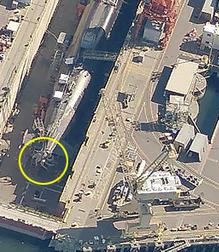Online Maps Reveal of State Secrets and Security Lapses
 Dan Twohig, a deck officer with the Washington state ferry service was using Microsoft Virtual Earth to review real estate on the west side of Puget Sound. Instead he found a state secret, a photo showing the secret propeller design of an Ohio-class ballistic missile submarine. He posted the publicly available image on his web site, which was picked up by search engines, and automatically distributed to readers interested in the key words used in his description.
Dan Twohig, a deck officer with the Washington state ferry service was using Microsoft Virtual Earth to review real estate on the west side of Puget Sound. Instead he found a state secret, a photo showing the secret propeller design of an Ohio-class ballistic missile submarine. He posted the publicly available image on his web site, which was picked up by search engines, and automatically distributed to readers interested in the key words used in his description.
The Navy Times soon published an article, questioning the motive of Mr. Twohig’s posting. Our posting provides other examples of recent satellite disclosures, and suggests a parallel to the debate on the public’s use of cryptography in electronic messaging.
Mr. Twohig’s discovery of a submarine propeller is part of a pattern. The month before, Google Maps revealed the existence of a new chinese ballistic missile submarine. From Darfur and the Gaza Strip to mapping outer space, online mapping tools are giving the public access to data and tools previously reserved for governments and technical organizations.
Like other introductions of new technologies, there are no clear ideological lines drawn through this discussion. Privacy advocates, identify risks in a variety of public mapping activities, while human rights and environmental advocates actively use this technology to make their public cases. Satellite data is also used by health organizations, such as to identify the shifting conditions which promote the spread of malaria.
The Navy Times online forum voiced the risk of providing terrorists with potentially sensitive information. While the public is comfortable that people a wide variety of motives may have street maps, the impact of broad use of satellite imagery is less known.
But this debate is muted because currently, commercial satellite images are limited both by regulation and practicality. Though these images are getting on the the web faster, most are still dated by one to three years. They are also less detailed and timely those received by governments who would have an active interest in submarine construction. This has allowed the public to enjoy the benefits of this information, and to see that its disclosure has in fact not been a dramatic driver of criminal activity.
Policy makers could be well served to seek parallels between this issue at the public use and regulation of cryptography in safeguarding email. This debate, which played out in the 1990’s, also involved a technology previously used mostly by government which gained broader public use. It respresented both a new public good, namely information security, and a significant threat to law enforcement’s legitimate need to gain information about criminal activities.
Just as with satellite technology, some limits were set on the strength of cryptography provided to the public, and provisions were made to provide access to authorities to allow access to commercially encrypted messages.

 The future of digital experiences will be built by strategists who grasp the full array of emerging business, social, and technical models. Specialties in user experience, branding, application design, and data science are laying the foundation for richer user experiences and business models breakthrough products and revenue based marketing.
The future of digital experiences will be built by strategists who grasp the full array of emerging business, social, and technical models. Specialties in user experience, branding, application design, and data science are laying the foundation for richer user experiences and business models breakthrough products and revenue based marketing.